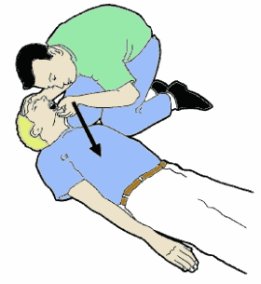 CLINICAL SIGNS:
CLINICAL SIGNS:
* the patient is in a state of apparent death :
– loss of consciousness, brutal and complete.
– the patient does not breathe or gasp.
– absence of carotid or femoral pulse, absence of heart sound at the auscultation.
DIFFERENTIAL DIAGNOSIS:
* syncope.
* profound hypothermia.
ETIOLOGY:
* heart causes:
– hypertrophic heart disease.
– ventricular fibrillation (70%) or inefficient ventricular tachycardia primitive.
– Primitive BAV.
– arrhythmogenic dysplasia of the right ventricle.
– long QT syndrome.
– tamponade, IDM or coronary insufficiency, pulmonary embolism, heart failure.
* respiratory causes:
– foreign body, obstructive laryngeal edema.
– respiratory depression due to drug poisoning or neurological involvement.
– suffocating pneumothorax, OAP, severe acute asthma.
* accidental causes:
– CO intoxication, intoxication by fire fumes, electrocution, drowning, hypothermia.
– hypovolemia.
Hypo or hyperkalemia.
ADDITIONAL TESTS:
* scope, ECG:
– asystole, idioventricular rhythms.
– FV, TV.
– apparently sinus rhythm in the case of electromechanical dissociation.
– extreme bradycardia.
TREATMENT:
* alert and record the time of start of resuscitation.
* make an electric shock immediately if possible because the first cause is ventricular fibrillation.
* setting in common condition:
– place the patient in a supine position on a hard plane.
– give a vigorous punch on the middle of the sternum.
– remove the dentures and possibly unclog the oropharynx, unclip tie, shirt and belt, and put the head hyperextension.
– place a cannula of Guedel.
– mouth-to-mouth ventilation , or mask with pure oxygen at 12-20 breaths / min (if the air does not pass a Heimlich maneuver).
– cardiac massage at 80 or 100 compressions per minute. (One can use the Ambu Cardiopompe).
– alternate ventilation and massage:
– if you are alone: 2 breaths for 15 compressions.
– if there are two rescuers: 1 insufflation for 5 compressions.
– put a venous route:
– the best is the subclavian which ensures the highest serum peaks.
– the fastest: the peripheral way (external jugular vein).
– infuse saline isotonic saline.
– if the venous route is impossible, use the endotracheal route but using higher dosages for the drugs (Adrenaline, Xylocaine, Atropine):
– 5 mg of Adrenaline diluted in 10 ml of water.
– inject this preparation using a tracheal suction probe as deeply as possible then insufflation of 2 to 3 large volumes.
* specific treatments, while continuing the basic gestures of survival:
– if ventricular fibrillation (VF) or ventricular tachycardia (VT) poorly supported:
– external electric shock immediately :
– with a manual defibrillator: start with 200 joules (J) (3 J / kg in the child), then if failure, make a new shock at: 200 J, then if failure at 360 J.
– with a semi-automatic defibrillator.
– then intubation and poses venous route.
– if failure, Adrenaline: 1 to 3 mg IV / 3 min.
– if failure, new defibrillations up to 3 shocks of 360 J.
– then, if failure: Xylocaine, 1 mg / kg IV.
– if failure, new series of 3 electric shocks of 360 J.
– if failure, bicarbonates: 1 mmol / kg IV every 10 minutes.
– if failure, return to adrenaline IV.
– if successful, take preventive measures: Xylocard 1-3 mg / min or Cordarone 600 mg / day with an electric syringe.
– if asystole:
– Adrenaline : 1-3 mg IV to be renewed every 3 minutes.
– Bicarbonates molar after 15 minutes on a route other than adrenaline at the initial dosage of 1 mEq / kg or 1 ml / kg IV and ½ mEq / kg / 15 min.
– if significant bradycardia:
– Adrenaline: 1 to 3 mg IV to be renewed every 3 minutes.
– if failure, Atropine: 1 mg IV / 3 min (maximum total dose: 0.05 mg / kg).
– if failure: electrosystolic drive.
– if torsade de pointe:
– Magnesium sulphate: 1.5-3 g IV slow in 2 minutes then 6-12 g / 24 h in the electric syringe.
– if electromechanical dissociation or idioventricular ryhtms:
– Adrenaline: 1-3 mg IV to renew eventually.
– Bicarbonates-molar 8.4%: 100-200 ml in 10 minutes, after 15 minutes, every 10 minutes.
– etiological treatment.
* monitor the disappearance of the mydriasis, the recoloration, the return of the pulse every 2 minutes.
* avoid the injection of Calcium, barbiturates, Glucose more harmful than beneficial.
* Official duration of resuscitation without effectiveness: 20 minutes unless drowned, hypothermic, child where resuscitation is continued longer.
* hospitalization as soon as possible if recovery.
